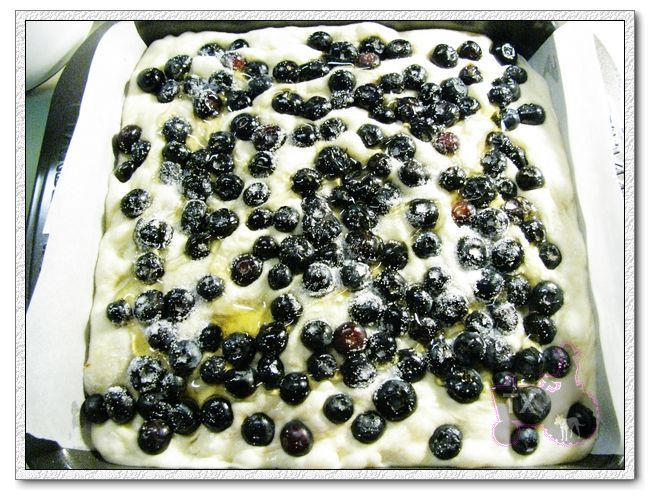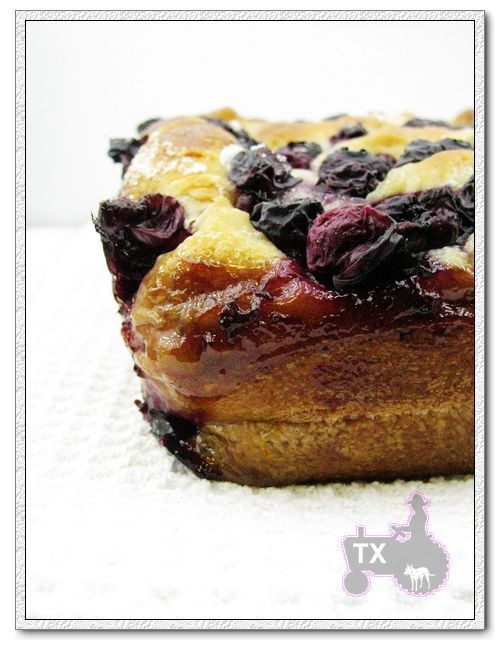
I have seen Schiacciata recipes from several books, as a big fan of savory focaccia, I've always wanted to try it. Recently we bought a lot of fresh blueberries on sale, so I combined several recipes, used blueberries instead of the usual concord grapes, added some rosemary flavor, and here's a beautiful schiacciata (i.e. sweet focaccia) that's delicious too.
- The night before, make sponge:
instant yeast, 1/2tsp
bread flour, 125g
water, 160g
mix well, cover, and sit at room temperature (70F) for 12 to 24 hours. I used it after 14, it had reached its max volume then, was very bubbly.
- Baking day:
sugar, 3tbsp
instant yeast, 1.25tsp
water, 205g
bread flour, 345g
salt, 1.5tsp
olive oil, 5tbsp (3tbsp for the dough, the rest for brushing the top)
fresh rosemary, 1 bunch
blueberries, 1lb
sugar for spreading on top, 3tbsp
honey for spreading on top, to taste
1. Put rosemary in olive oil, heat, cool to room temperature and soak for about an hour, discard rosemary.
2. Mix 3tbsp of sugar, yeast, water, flour, salt, 3tbsp of oil, sponge, autolyse for 20 minutes. Knead well until gluten is strong. The dough is pretty wet.
3. Bulk fermentation for 90 to 120 minutes, until double. (If it's not very well kneaded at step 2, some stretch and fold would be necessary. I prefer my focaccia crumb to be fine and even, so I kneaded quite a bit.)
4. Divide into 2, round and rest for 10 minutes. Take one piece and roll it out to about 9X9 inch, put into a prepared 9inch square pan. (I like my focaccia thicker, so I used this pan to give it a square shape and limit its spread, of course you can use any other pan or just a large pizza pan to let the dough spread out more.)
5. Spread half of the blueberries and 2tbsp of sugar on top, use fingers to press the berries down into dough, ideally break up the berries a little

6. Roll out the other piece of dough and cover on top, pinch together the seams

7. Proof until double again, 30 to 60 minutes. Use fingers to dimple the dough again, make it spread to fill the pan. Spread the other half of blueberries and 1tbsp of sugar on top, press down to make sure the berries sit into the dough, wont' fall off during baking. Drizzle honey on top.

8. Bake at 400F for 45 minutes.

I love how the blueberries got baked "into" the dough, it's like making blueberry jam and the bread in one step! I like the crumb, soft, open with even holes, if you prefer your foccacia to have big irregular holes, you might want to knead less, fold more, and dimple a bit less in the end.

What elevates the bread from good to great is the rosemary! Combined with olive oil, it provides a savory background to the sour and sweet taste of blueberries, very Italian, very delicious.

With the amount of sugar and honey I put in, the bread is not that sweet, mostly from the natural taste of blueberries, you can certainly use more sugar/honey if you like it sweeter. I am so happy with the result I want to make the mroe traditional version too, using concord grapes and raisins.
